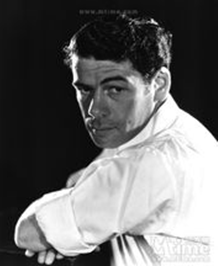

His acting quality, usually playing a powerful character, such as Scarface, was partly a result of his intense preparation for his parts, often immersing himself in study of the real character's traits and mannerisms. He was also highly skilled in using makeup techniques, a talent he learned from his parents, who were also actors, and from his early years on stage with the Yiddish Theater, in New York. At the age of 12, he played the stage role of an 80-year-old man; in one of his films, Seven Faces, he played seven different characters.
He was nominated six times for an Oscar, winning once as Best Actor in The Story of Louis Pasteur.
Early life and career
Muni was born to a Jewish family in Lemberg, Galicia, a province of the Austro-Hungarian Empire, now Lviv, Ukraine (formerly Lwów, Poland). His family emigrated to the United States in 1902.
He began his acting career on the Yiddish stage in New York City, where his parents were actors with the Yiddish theatre. As a teenager, he developed an affinity for makeup and often played characters much older. Film historian Robert Osborne notes that his makeup skills were so creative, that for most of his roles, "he transformed his appearance so completely, he was dubbed 'the New Lon Chaney.'" In his first stage role, at the age of 12, he played the role of an eighty-year-old man.
He was quickly recognized by Maurice Schwartz, who signed him up with his Yiddish Art Theater. Edward G. Robinson and Paul Muni were cousins to Charles M. Fritz, who was a notable actor during the Great Depression. In 1921, he married Bella Finkel (February 8, 1898 - October 1, 1971), an actress in the Yiddish theatre. They remained married until Muni's death in 1967.
A 1925 New York Times article singled out his and Sam Kasten's performances at the People's Theater as among the highlights of that year's Yiddish theater season, describing them as second only to Ludwig Satz.
Personal life
He retired from filmmaking in 1959, soon after receiving his sixth Academy Award nomination for The Last Angry Man; however, he made a final television appearance in the series Saints and Sinners in 1962.
In his private life, he was considered "exceedingly shy", and would show agony anytime he was recognized while out shopping or dining. He enjoyed reading and going for walks with his wife in secluded sections of Central Park, and would be at the theater by 7:30PM to prepare for his performances each night. After retiring from acting, he lived in California, in what was considered an "austere" setting, where he and his wife enjoyed their privacy. In his den, which he called his "Shangri-La", he spent his time reading books and listening to the radio.
Muni died of a heart disorder in Montecito, California in 1967, aged 71. Muni died the same year that his Angel On My Shoulder co-star Claude Rains, and another co-star, Spencer Tracy, also died. Muni has a star on the Hollywood Walk of Fame at 6435 Hollywood Blvd. He is interred in the Hollywood Forever Cemetery, Hollywood, CA.



















